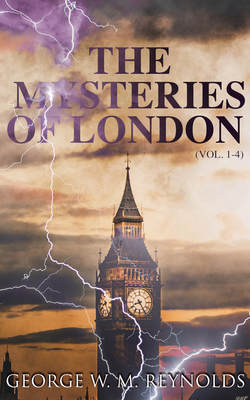Читать книгу The Mysteries of London (Vol. 1-4) - George W. M. Reynolds - Страница 12
CHAPTER VII.
THE BOUDOIR.
ОглавлениеIT was the morning after the events related in the last chapter.
The scene changes to a beautiful little villa in the environs of Upper Clapton.
This charming retreat, which consisted of a main building two storeys high, and wings each containing only one apartment, was constructed of yellow bricks that had retained their primitive colour, the dwelling being too far from the metropolis to be affected by its smoky exhalations.
The villa stood in the midst of a small garden, beautifully laid out in the French style of Louis XV.; and around it—interrupted only by the avenue leading to the front door of the dwelling—was a grove of evergreens. This grove formed a complete circle, and bounded the garden; and the entire enclosure was protected by a regular paling, painted white.
This miniature domain, consisting of about four acres, was one of the most beautiful spots in the neighbourhood of London; and behind it—far as the eye could reach—stretched the green fields, smiling and cultivated like those of Tuscany.
In front of the villa was a small grass plot, in the centre of which was a basin of clear and pellucid water, upon whose surface floated two noble swans, and other aquatic birds of a curious species.
Every now and then the silence of the morning was broken by the bay of several sporting-dogs, which occupied, in the rear of the building, kennels more cleanly and more carefully attended upon than the dwellings of many millions of Christians.
And yet the owner of that villa wanted not charity: witness the poor woman and two children who have just emerged from the servants' offices laden with cold provisions, and with a well-filled bundle of other necessaries.
At the door of a stable a groom was seen dismounting from the back of a thorough-bred chestnut mare, which had just returned from an airing, and upon which he cast a glance of mingled pride and affection.
The windows of the villa were embellished with flowers in pots and vases of curious workmanship; and outside the casements of the chambers upon the first floor were suspended cages containing beautiful singing birds.
To the interior of one of those rooms must we direct the attention of the reader. It was an elegant boudoir: and yet it could scarcely justify the name; for by a boudoir we understand something completely feminine, whereas this contained articles of male and female use and attire strangely commingled—pell-mell—together.
Upon a toilet-table were all the implements necessary for the decoration and embellishment of female beauty; and carelessly thrown over a chair were a coat, waistcoat, and trousers. A diminutive pair of patent-leather Wellington boots kept company with delicate morocco shoes, to which sandals were affixed. A huge press, half-open, disclosed an array of beautiful dresses—silk, satin, and precious stuffs of all kinds; and on a row of pegs were hung a scarlet hunting-coat, a shooting-jacket, a jockey-cap, and other articles of attire connected with field sports and masculine recreations. Parasols, foils, single-sticks, dandy-canes, and hunting-whips, were huddled together in one corner of that bureau. And yet all the confusion of these various and discrepant objects was so regular in appearance—if the phrase can be understood—that it seemed as if some cunning hand had purposely arranged them all so as to strike the eye in a manner calculated to encourage the impression that this elegant boudoir was inhabited by a man of strange feminine tastes, or a woman of extraordinary masculine ones.
